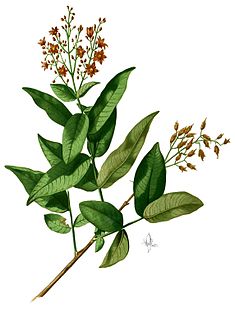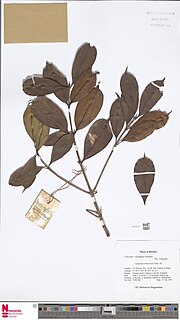
Cratoxylum is a genus of flowering plants in the family Hypericaceae, native to tropical Asia. The generic name is from the Greek meaning "strong wood", referring to the timber.

Cratoxylum arborescens is a plant in the family Hypericaceae. The specific epithet arborescens is from the Latin meaning "tree-like".
Alangium longiflorum is a tree in the dogwood family Cornaceae. The specific epithet longiflorum is from the Latin meaning "long flowers".
Anisophyllea corneri is a tree of tropical Asia in the family Anisophylleaceae. It is named for the English botanist Edred John Henry Corner.
Anisophyllea globosa is a tree of Borneo in the family Anisophylleaceae. The specific epithet globosa is from the Latin meaning "round", referring to the fruits.
Canarium littorale is a tree found in tropical Asia and is a member of the incense tree family Burseraceae. The specific epithet littorale is from the Latin meaning "of the seashore", referring to its habitat.
Cassine viburnifolia is a mangrove plant of tropical Asia in the staff vine family Celastraceae. The specific epithet viburnifolia refers to how the plant's leaves resemble those of the genus Viburnum.
Maranthes corymbosa is a tree in the family Chrysobalanaceae. The specific epithet corymbosa is from the Greek meaning "cluster", referring to the clustered inflorescences.
Combretocarpus is a monotypic genus of tree in the Anisophylleaceae family. The generic name combretocarpus is from the Greek, referring to the resemblance of its fruit to that of the genus Combretum. As of April 2014 The Plant List recognises the single species Combretocarpus rotundatus.
Canarium dichotomum is a tree in the family Burseraceae. The specific epithet dichotomum is from the Latin meaning "forked", referring to the branching of the inflorescences.
Canarium denticulatum is a tree in the family Burseraceae. The specific epithet denticulatum is from the Latin meaning "small teeth", referring to the leaf margin.

Dacryodes rostrata is a tree in the family Burseraceae. The specific epithet rostrata is from the Latin meaning "beaked", referring to the narrow-tipped leaves.
Dacryodes rugosa is a tree in the family Burseraceae. The specific epithet rugosa is from the Latin meaning "wrinkled", referring to the leaflets.
Mastixia cuspidata is a tree in the family Nyssaceae. The specific epithet cuspidata is from the Latin meaning "sharp-pointed", referring to the leaf apex.
Mastixia trichotoma is a tree in the family Nyssaceae. The specific epithet trichotoma is from the Greek meaning "three parts", referring to the three-branched inflorescence.
Picrasma javanica is a tree in the family Simaroubaceae. The specific epithet javanica is from the Latin meaning "of Java".
Buchanania insignis is a tree of Borneo in the cashew and sumac family Anacardiaceae. The specific epithet insignis is from the Latin meaning "remarkable".
Buchanania sessilifolia is a tree in the family Anacardiaceae. The specific epithet sessilifolia is from the Latin meaning "leaf without stalk", referring to the sessile leaves.
Dracontomelon costatum is a tree in the cashew and sumac family Anacardiaceae. The specific epithet costatum is from the Latin meaning "ribbed", referring to the leaf veins.

Gluta velutina is a plant of tropical Asia in the cashew and sumac family Anacardiaceae. The specific epithet velutina is from the Latin meaning "velvety", referring to the inflorescences.



